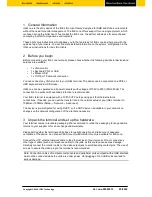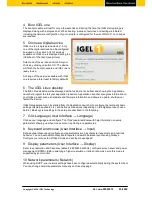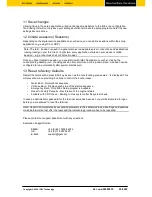
1 General Information
IGEL
one
is the entry device of the IGEL thin client family, designed for SMB and Soho environments
without the need for central management. The IGEL
one
offers support for one single protocol, which
is chosen during the initial boot. Thus makes the IGEL
one
the perfect end device for server-based
computing in small homogeneous environments.
These brief setup instructions will introduce you to the feature set of IGEL
one
and help you with the
quick set up of your clients. You will find more detailed information on the sytems' configuration in the
IGEL user instructions for linux thin clients.
2 Before you begin
Before connecting your IGEL
one
terminal, please check whether the following peripheral devices and
services are available:
•
1x VGA monitor
•
1x Keyboard PS/2 or USB
•
1x Mouse USB
•
1x 10/100 UTP network connection
You can connect any VGA monitor to your IGEL terminal. The device can be connected to a PS/2 or
USB keyboard and a USB mouse.
IGEL
one
can be operated on all power networks with voltages of 100V to 250V (50Hz-60Hz). The
connection to a socket with overload protection is recommended.
Your IGEL terminal is equipped with a 10/100 UTP auto sensing port for ethernet network
connections. If needed, you can set the transfer rate in the network setup of your IGEL terminal to
10Mb/s or 100Mb/s (Setup
→
Network
→
Advanced).
The device is pre-configured for using DHCP, so if a DHCP server is available in your network no
changes on the network configuration of the client are necessary.
3 Unpack the terminal and set up the hardware
Your terminal comes in reusable packaging. We recommend to retain the packaging for any possible
returns to your supplier or for an exchange under warranty.
Please bolt together the terminal and its base for upright operation and take care of adequate
ventilation of the device. An optional VESA mount (wall/monitor mount) is available for IGEL
one.
Connect the UTP ethernet network cable to the ethernet jack of your terminal. Do not connect any
other type of cable (such as a telephone cable) to this jack, as this could cause serious damage.
Carefully connect the monitor cable to the video output jack to avoid bending contact pins. The use of
screws to secure the video plug to the terminal is recommended.
Copyright © 2009 IGEL Technology
Ver. one-20090515 05/2009
Note: Connection cables of computer components and peripheral units equipped with a USB interface
must not be connected while the units are under power. Hot plugging of non-USB units can lead to
serious damage.






















